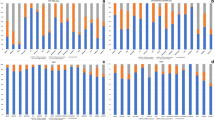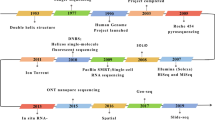Abstract
Canine atopic dermatitis (AD) is a very common inflammatory skin disease, but limited data are available on the genetic characterization (somatic mutations, microarrays, and genome-wide association study (GWAS)) of skin lesions in affected dogs. microRNAs are good biomarkers in inflammatory and neoplastic diseases in people. The aim of this study was to evaluate microRNA expression in the skin of atopic beagles, before and after exposure to Dermatophagoides farinae. Four atopic and four unrelated age-matched healthy beagle dogs were enrolled. Total RNA was extracted from flash-frozen skin biopsies of healthy and atopic dogs. For the atopic dogs, skin biopsies were taken from non-lesional (day 0) and lesional skin (day 28 of weekly environmental challenge with Dermatophagoides farinae). Small RNA libraries were constructed and sequenced. The microRNA sequences were aligned to CanFam3.1 genome. Differential expressed microRNAs were selected on the basis of fold-change and statistical significance (fold-change ≥ 1.5 and p ≤ 0.05 as thresholds. A total of 277 microRNAs were sequenced. One hundred and twenty-one differentially regulated microRNAs were identified between non-lesional and healthy skin. Among these, two were increased amount and 119 were decreased amount. A total of 45 differentially regulated microRNAs between lesional and healthy skin were identified, 44 were decreased amount and one was increased amount. Finally, only two increased amount microRNAs were present in lesional skin when compared with that of non-lesional skin. This is the first study in which dysregulation of microRNAs has been associated with lesional and non-lesional canine AD. Larger studies are needed to understand the role of microRNA in canine AD.





Similar content being viewed by others
References
Agler CS, Friedenberg S, Olivry T, Meurs KM, Olby NJ (2019) Genome-wide association analysis in West Highland White Terriers with atopic dermatitis. Vet Immunol Immunopathol 209:1–6
Anders S, Huber W (2010) Differential expression analysis for sequence count data. Genome Biol 11:R106
Ardesjö-Lundgren B, Tengvall K, Bergvall K, Farias FHG, Hedhammar Å, Lindblad-Toh K, Andersson G (2017) Comparison of cellular location and expression of plakophilin-2 in epidermal cells from nonlesional atopic skin and healthy skin in German shepherd dogs. Vet Dermatol 28:377–e88
Bizikova P, Pucheu-Haston CM, Eisenschenk MN, Marsella R, Nuttal T, Santoro D (2015) Review: role of genetics and the environment in the pathogenesis of canine atopic dermatitis. Vet Dermatol 26:95–e26
Buza T, Arick M, Wang H, Paterson DG (2014) Computational prediction of disease microRNAs in domestic animals. BMC Res Notes 7:403
Chervet L, Galichet A, McLean WH, Chen H, Suter MM, Roosje PJ, Muller EJ (2010) Missing C-terminal filaggrin expression, NFkappaB activation and hyperproliferation identify the dog as a putative model to study epidermal dysfunction in atopic dermatitis. Exp Dermatol 19:e343–e346
Dissanayake E, Inoue Y (2016) MicroRNAs in allergic disease. Curr Allergy Asthma Rep 16:67
Hillier A, Griffin CE (2001) The ACVD task force on canine atopic dermatitis (I): incidence and prevalence. Vet Immunol Immunopathol 81:147–151
Hulanicka M, Garncarz M, Parzeniecka-Jaworska M, Jank M (2014) Plasma miRNAs as potential biomarkers of chronic degenerative valvular disease in Dachshunds. BMC Vet Res 10:205
Ichii O, Otsuka S, Ohta H, Yabuki A, Horino T, Kon Y (2014) MicroRNA expression profiling of cat and dog kidneys. Res Vet Sci 96:299–303
Kim HJ, Cronin M, Ahrens K, Papastavros V, Santoro D, Marsella R (2016) A comparative study of epidermal tight junction proteins in a dog model of atopic dermatitis. Vet Dermatol 27:40–e11
Koenig EM, Fisher C, Bernard H, Wolenski FS, Gerrein J, Carsillo M, Gallacher M, Tse A, Peters R, Smith A, Meehan A, Tirrell S, Kirby P (2016) The beagle dog MicroRNA tissue atlas: identifying translatable biomarkers of organ toxicity. BMC Genomics 17:649
Ledin A, Bergvall K, Salmon Hillbertz N, Hansson H, Andersson G, Hedhammar Å, Hellman L (2006) Generation of therapeutic antibody responses against IgE in dogs, an animal species with exceptionally high plasma IgE levels. Vaccine 24:66–74
Marsella R, De Benedetto A (2017) Atopic dermatitis in animals and people: an update and comparative review. Vet Sci 4:E37
Morlang I, Weber K, Von Bomhardt W, Majzoub-Altweck M, Mueller RS (2018) Cutaneous miRNA expression in Labrador and golden retrievers. Vet Dermatol 29:367–368
Oh DY, Schumann RR, Hamann L, Neumann K, Worm M, Heine G (2009) Association of the toll-like receptor 2 A-16934T promoter polymorphism with severe atopic dermatitis. Allergy 64:1608–1615
Olivry T, Marsella R, Iwasaki T, Mueller R, International Task Force On Canine Atopic Dermatitis (2007) Validation of CADESI-03, a severity scale for clinical trials enrolling dogs with atopic dermatitis. Vet Dermatol 18:78–86
Pucheu-Haston CM, Bizikova P, Marsella R, Santoro D, Nuttal T, Eisenschenk M (2015a) Review: lymphocytes, cytokines, chemokines and the T-helper 1-T-helper 2 balance in canine atopic dermatitis. Vet Dermatol 26:124–e32
Pucheu-Haston CM, Bizikova P, Eisenschenk MN, Santoro D, Nuttal T, Marsella R (2015b) Review: the role of antibodies, autoantigens and food allergens in canine atopic dermatitis. Vet Dermatol 26:115–e30
Pucheu-Haston CM, Santoro D, Bizikova P, Eisenschenk M, Marsella R, Nuttal T (2015c) Review: innate immunity, lipid metabolism and nutrition in canine atopic dermatitis. Vet Dermatol 26:104–e28
Rebane A, Akdis CA (2013) MicroRNAs: essential players in the regulation of inflammation. J Allergy Clin Immunol 132:15–26
Roussel AJ, Bruet V, Marsella R, Knol AC, Bourdeau PJ (2015) Tight junction proteins in the canine epidermis: a pilot study on their distribution in normal and in high IgE-producing canines. Can J Vet Res 79:46–51
Rożalski M, Rudnicka L, Samochocki Z (2016) MiRNA in atopic dermatitis. Adv Dermatol Allergol 33:157–162
Salpietro C, Rigoli L, Miraglia Del Giudice M, Cuppari C, Di Bella C, Salpietro A, Maiello N, La Rosa M, Marseglia GL, Leonardi S, Briuglia S, Ciprandi G (2011) TLR2 and TLR4 gene polymorphisms and atopic dermatitis in Italian children: a multicenter study. Int J Immunopathol Pharmacol 24:33–40
Santoro D, Marsella R (2014) Animal models fo allergic diseases. Vet Sci 1:192–212
Santoro D, Marsella R, Pucheu-Haston CM, Eisenschenk M, Nuttal T, Bizikova P (2015) Review: pathogenesis of canine atopic dermatitis: skin barrier and host-micro-organism interaction. Vet Dermatol 26:84–e25
Sonkoly E, Wei T, Janson PC, Sääf A, Lundeberg L, Tengvall-Linder M, Norstedt G, Alenius H, Homey B, Scheynius A, Ståhle M, Pivarcsi A (2007) MicroRNAs: novel regulators involved in the pathogenesis of psoriasis? PLoS One 2:e610
Sonkoly E, Janson P, Majuri ML, Savinko T, Fyhrquist N, Eidsmo L, Xu N, Meisgen F, Wei T, Bradley M, Stenvang J, Kauppinen S, Alenius H, Lauerma A, Homey B, Winqvist O, Ståhle M, Pivarcsi A (2010) MiR-155 is overexpressed in patients with atopic dermatitis and modulates T-cell proliferative responses by targeting cytotoxic T lymphocyte-associated antigen 4. J Allergy Clin Immunol 126:581–9.e1-20
Sun H, Zhong D, Jin J, Liu Q, Wang H, Li G (2018) Upregulation of miR-215 exerts neuroprotection effects against ischemic injury via negative regulation of Act1/IL-17RA signaling. Neurosci Lett 662:233–241
Tengvall K, Kierczak M, Bergvall K, Olsson M, Frankowiack M, Pielberg G, Carlborg Ö, Leeb T, Andersson G, Hammarström L, Hedhammar Å, Lindblad-Toh K (2013) Genome-wide analysis in German shepherd dogs reveals association of a locus on CFA27 with atopic dermatitis. PLoS Genet 9(5):e1003475
Tengvall K, Kozyrev S, Kierczak M, Bergvall K, Farias FHG, Ardesjö-Lundgren B, Olsson M, Murén E, Hagman R, Leeb T, Pielberg G, Hedhammar Å, Andersson G, Lindblad-Toh K (2016) Multiple regulatory variants located in cell type-specific enhancers within the PKP2 locus form a major risk and a protective haplotype for canine atopic dermatitis in German shepherd dogs. BMC Genet 17:97
Thyssen JP, Ross-Hansen K, Johansen JD, Zachariae C, Carlsen BC, Linneberg A, Bisgaard H, Carson CG, Nielsen NH, Meldgaard M, Szecsi PB, Stender S, Menné T (2012) Filaggrin loss-of-function mutation R501X and 2282del4 carrier status is associated with fissured skin on the hands: results from a cross-sectional population study. Br J Dermatol 166:46–53
Vennegaard MT, Bonefeld CM, Hagedorn PH, Bangsgaard N, Løvendorf MB, Odum N, Woetmann A, Geisler C, Skov L (2012) Allergic contact dermatitis induces upregulation of identical microRNAs in humans and mice. Contact Dermatitis 67:298–305
White AG, Santoro D, Ahrens K, Marsella R (2018) Single blinded, randomized, placebo-controlled study on the effects of ciclosporin on cutaneous barrier function and immunological response in atopic beagles. Vet Immunol Immunopathol 197:93–101
Wood SH, Ke X, Nuttall T, McEwan NA, Ollier WE, Carter SD (2009) Genome-wide association analysis of canine atopic dermatitis and identification of disease related SNPs. Immunogenetics 61:765–772
Wood SH, Ollier WE, Nuttall T, McEwan NA, Carter SD (2010) Despite identifying some shared gene associations with human atopic dermatitis the use of multiple dog breeds from various locations limits detection of gene associations in canine atopic dermatitis. Vet Immunol Immunopathol 138:193–197
Wu S, Du X, Wu M, Du H, Shi X, Zhang T (2016) MicroRNA-409-3p inhibits osteosarcoma cell migration and invasion by targeting catenin-δ1. Gene 584:83–89
Zhang Q, Wang W, Li J, Tian SY, Zhang TZ (2015) Decreased miR-187 induces retinal ganglion cell apoptosis through upregulating SMAD7 in glaucoma. Biomed Pharmacother 75:19–25
Zhao FR, Su S, Zhou DH, Zhou P, Xu TC, Zhang LQ, Cao N, Qi WB, Zhang GH, Li SJ (2014) Comparative analysis of microRNAs from the lungs and trachea of dogs (Canis familiaris) infected with canine influenza virus. Infect Genet Evol 21:367–374
Author information
Authors and Affiliations
Corresponding author
Additional information
Publisher’s note
Springer Nature remains neutral with regard to jurisdictional claims in published maps and institutional affiliations.
Domenico Santoro and Antonio Di Loria equally contributed to this work.
Rights and permissions
About this article
Cite this article
Santoro, D., Di Loria, A., Mirante, T. et al. Identification of differentially expressed microRNAs in the skin of experimentally sensitized naturally affected atopic beagles by next-generation sequencing. Immunogenetics 72, 241–250 (2020). https://doi.org/10.1007/s00251-020-01162-w
Received:
Accepted:
Published:
Issue Date:
DOI: https://doi.org/10.1007/s00251-020-01162-w




